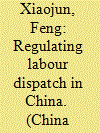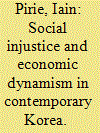| Srl | Item |
| 1 |
ID:
163492


|
|
|
|
|
| Summary/Abstract |
This article suggests cautious optimism toward the prevailing Polanyian countermovement discourse by providing a timely and comprehensive examination of the enforcement of the labour dispatch regulation in China. Since the enactment of the regulation, some enterprises have narrowed the remuneration gap between agency workers and formal employees, while others have retained a large gap in overtime pay, bonuses, and welfare benefits between these two groups of workers. The regulation has reduced the number of agency workers, but has invoked the abuse of the more precarious ‘outsourced’ workers as well. The regulation has had little effect on limiting the use of agency labour to temporary, auxiliary, or substitute positions, raising the requirements of engaging in the labour dispatch business, or stabilizing the employment of agency workers. This article contributes to the extant literature on regulatory enforcement by examining the effects of non-standard employment regulation, highlighting the variance of labour law compliance among enterprises with different types of ownership, and demonstrating how China’s ongoing transformation from a planned to a market economy since the 1980s and from high growth to a new normal since 2010 has fundamentally constrained the full implementation of its labour protection regulation.
|
|
|
|
|
|
|
|
|
|
|
|
|
|
|
|
| 2 |
ID:
073640


|
|
|
|
|
| Publication |
2006.
|
| Summary/Abstract |
This article examines the processes of labor market restructuring and welfare reform in South Korea since the 1997/98 crisis, arguing that the Korean state-capital complex has succeeded in effecting a substantial redistribution of income from labor to capital. This redistribution of income has played a critical role in enhancing Korea's international competitiveness and in facilitating a return to sustained growth. The principal mechanisms through which this redistribution has been achieved are the intensified exploitation of weaker sections of the proletariat and the reduction of the traditionally more protected organized sections of the workforce in major firms. At the same time, the state has strengthened welfare safety nets and sought to place concerns about structural competitiveness at the heart of the welfare regime through the promotion of vocational training. What has been most striking about the process of welfare reform, however, has been the capacity of the state to limit the growth of welfare expenditures/provision whilst simultaneously creating massive new labor market insecurities. As a result of the success of the Korean state in restructuring labor markets in order to effect a redistribution of income from weaker sections of the proletariat to capital and limiting the growth of social spending we have witnessed a marked increase in inequality since 1997. Korea's apparent success in transforming itself into a competitive, dynamic neoliberal economy must, therefore, be understood as being symbiotically linked to the intensification of inequality.
|
|
|
|
|
|
|
|
|
|
|
|
|
|
|
|